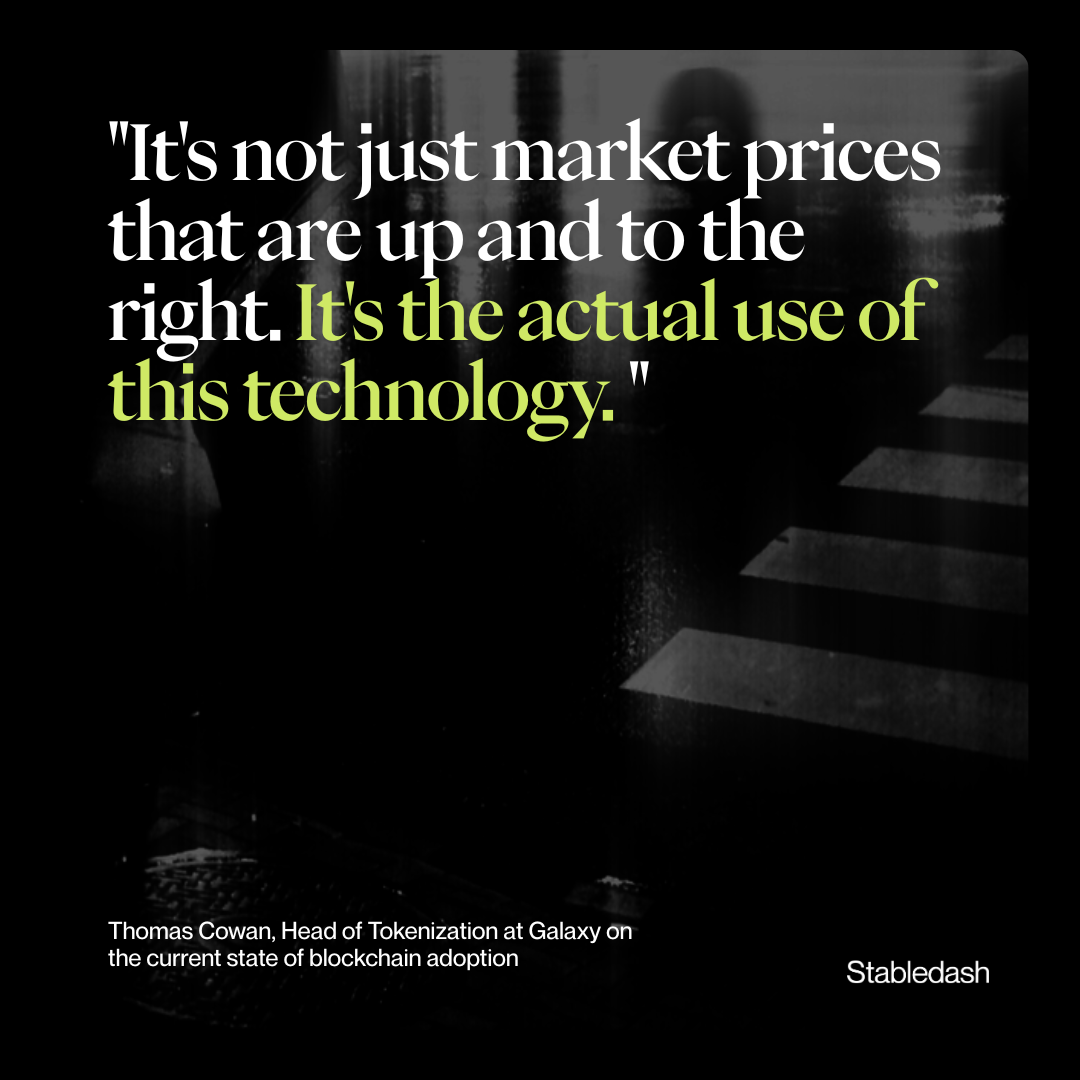Stabled Up by The Rollup
Why Private Stablecoins Are Winning the War for the Digital Dollar
While prices hit all-time highs, the real story is the market’s decisive shift toward utility-driven stablecoins over state-led CBDCs. A deep dive with Head of Tokenization at Galaxy, Thomas Cowan.
October 22, 2025

Companies mentioned:
Why Private Stablecoins Are Winning the War for the Digital Dollar
The $300 Billion Question Facing Regulators
The private stablecoin market has swelled to over $300 billion, a figure that represents a large-scale, real-world experiment in digital currency. This rapid, market-driven growth has fundamentally changed the conversation for global policymakers. The question is no longer if digital dollars should exist, but how to govern the private sector model that is already scaling and winning user adoption.
Loading...
This presents an urgent challenge that pits innovation against systemic safety. As former Stablecoin and CBDC Analyst/Researcher at the Federal Reserve Bank of Boston, Ripple and Harvard, Thomas Cowan, now Head of Tokenization at Galaxy, frames it: the goal is to determine "how do you regulate it to be able to ensure that that capital can move in a very efficient manner but also is used in an inherent and safe and contained way."
The market itself, however, is providing a clear answer.
An analytical review of adoption data, technological development, and user preference reveals a powerful thesis: the current financial landscape shows a distinct preference for private, market-led stablecoins over the top-down, state-controlled Central Bank Digital Currency (CBDC) models.
The market has already chosen its preferred rails for the digital dollar, and the primary task for regulators is to build a safe framework around this proven innovation.
A Unique Perspective Forged at the Fed, Ripple, and Galaxy
Understanding this complex shift requires a perspective that bridges monetary policy, protocol-level technology, and institutional capital flows. Cowan’s career provides a uniquely credible lens for this analysis. As one observer noted, his experience is a rare combination in the industry.
"I don't think we've ever had someone who has been at the Federal Reserve and also Ripple and is now the head of tokenization at Galaxy. That is a very unique position that you're holding in the industry."
This trifecta of perspectives is essential for a clear-eyed assessment of the digital dollar landscape:
- The Federal Reserve provides a deep understanding of monetary policy, financial stability, and the state’s perspective on the risks and motivations behind CBDCs.
- Ripple offers front-line experience in building and scaling protocol-level technology for cross-border payments, revealing the real-world challenges and opportunities of utility.
- Galaxy delivers an institutional view on market structure, tokenization, and where sophisticated capital is flowing in the current environment.
This combination of experiences enables a clear analysis of why the market is diverging, with one model flourishing while the other struggles to find its footing.
Bull Market Signals a Deeper Shift to Utility
While Bitcoin's all-time highs dominate headlines, the more significant and enduring trend is the structural shift from pure price speculation to real-world utility. The evidence for this is found not just in rising asset prices, but in the maturation of the regulatory and policy conversation.

As noted during the episode,
"it's not just market prices that are up and to the right. It's the actual use of this technology. Hester Pierce is talking about cryptography and privacy."
This observation is critical.
When a sitting SEC Commissioner (Hester Pierce) gives speeches on the nuances of privacy-preserving technologies like cryptography and zero-knowledge proofs, it signals a profound evolution. Policymakers are now engaging with the qualities and features of the technology, a direct result of its proven utility in the market.
This stands in stark contrast to previous cycles driven primarily by speculative narratives. The current growth is anchored in tangible use cases, with stablecoins leading the charge. Research confirms this trend, showing that stablecoin use in speculative trading has declined by 90% over the past five years, while its role in payments, treasury management, and DeFi has become structural.
Why Today’s Stablecoins Are Winning Against Early CBDCs
The market’s preference becomes undeniable when comparing the adoption trajectories of private stablecoins and state-led CBDCs. The framing of "positive impact" stablecoins versus "potentially treacherous CBDCs" is validated by a stark divergence in real-world data.
The Success of Market-Led Innovation
Private stablecoins have demonstrated explosive, organic growth because they solve real problems for users.
- Exponential Growth: The total supply of stablecoins surged from under $5 billion in 2019 to over $300 billion by mid-2025, a more than 50-fold increase.
- Surpassing Traditional Rails: In 2024, annual stablecoin transaction volume hit $18.4 trillion, exceeding the annual volumes of both Visa ($15.7 trillion) and Mastercard ($9.8 trillion).
- Proven Use Cases: This volume is driven by utility in areas like corporate treasury management, DeFi collateral, and cross-border remittances, where a 2025 study found that 26% of U.S.-based remittance users have already used stablecoins.
Loading...
Loading...
The Struggles of State-Led Pilots
In contrast, CBDC pilots have been characterized by low adoption, technical delays, and public resistance, often being described by analysts as a series of "abandoned experiments, embarrassing flops and monumental exercises in policymaker hubris."
- Nigeria's eNaira: A year after its 2021 launch, 98.5% of wallets were inactive. By March 2024, it accounted for just 0.36% of currency in circulation.
- China's e-CNY: Despite being the world's largest pilot, its circulation represents only 0.16% of China’s M0 money supply as of mid-2024, facing intense competition from existing private payment apps.
- Global Deferments: Countries including Canada, Denmark, and Japan have postponed or abandoned retail CBDC plans, citing public opposition over privacy and limited added value.
The data shows a clear verdict: users are actively choosing the permissionless, efficient, and developer-friendly model offered by the private sector.
Privacy and Optionality Emerge as Key Differentiators
The ultimate trump card for stablecoins is not just efficiency but the preservation of privacy and optionality. This is the core utility that users are decisively choosing. Privacy is a fundamental requirement for both commercial activity and individual sovereignty, a value proposition that private, decentralized systems are uniquely positioned to offer.
Concerns over surveillance are a primary barrier to CBDC adoption globally. A Bank for International Settlements (BIS) survey confirmed that privacy expectations are a "key determinant of adoption."
In the U.S., these fears are so pronounced that a proposed bill aims to prohibit the Federal Reserve from issuing a CBDC that is not "open, permissionless, and private."
From the perspective of a former Fed insider, the risks of a centralized, state-run payment ledger are profound. Such a system could create a single point of control and surveillance, fundamentally altering the relationship between a citizen and their money. Private stablecoins, operating on open networks, offer an alternative that aligns with the principles of economic freedom and competition.
A Blueprint for Efficient and Safe Digital Dollars
The success of the market-led model does not eliminate the need for regulation; it clarifies its purpose. The goal is to create a framework that harnesses the efficiency of private innovation while ensuring financial stability and consumer protection. Drawing from Cowan's balanced perspective, a pragmatic blueprint for regulation emerges, based on several core principles.
- Regulate the Issuer, Not the Protocol: Policy should focus on the entities that issue stablecoins and manage reserves. Mandating 1:1 reserve transparency, regular audits, and clear standards for eligible reserve assets would ensure stability without stifling protocol-level innovation on open networks.Embrace Open Standards and Interoperability: Instead of picking a single technology or creating a walled garden, regulators should encourage the development of open standards that allow different stablecoins and ledgers to interact. This fosters competition and prevents the formation of monopolies.Prioritize User Protection Through Transparency: Regulation should ensure that the risks associated with different stablecoin models are clearly and accurately disclosed to users. This empowers consumers to make informed choices while allowing the market to experiment with new models.
The Path from Echo Chamber to Real-World Adoption
Establishing a clear and intelligent regulatory framework for private stablecoins is the single most important step to "breaking crypto out of its echo chamber." A thriving, well-regulated market for digital dollars serves as the foundational bridge connecting the traditional financial system with the broader world of digital assets.
When policymakers, institutions, and enterprises see a functional, safe, and efficient digital dollar system operating at scale, it dramatically de-risks the entire asset class. This foundational layer of trust and utility paves the way for the next frontier of financial innovation: the tokenization of real-world assets, from securities and real estate to carbon credits and intellectual property. A trusted digital dollar is the gateway to this multi-trillion-dollar opportunity.
Why the Digital Dollar Market Is Still in Its First Inning
The most crucial insight for policymakers and investors is the sheer scale of the remaining opportunity. As Cowan astutely observes, the current market, while seemingly large, is just the beginning.
"Again we're still so early. It's funny how to us 280 290 billion in stable coins is so big but in in the trillions that currencies live on it's tiny. So we we have a long a long way to go."
Loading...
To contextualize this, the ~$300 billion stablecoin market represents less than 0.5% of the global M2 money supply, which stands at over $100 trillion. The total addressable market encompasses trillions in daily foreign exchange, global trade finance, and B2B payments.
The market has already rendered its initial verdict, choosing the speed, efficiency, and optionality of private stablecoins.
The path forward is clear.
The opportunity for growth is immense if regulators can successfully design a framework that nurtures this proven innovation while guaranteeing safety and transparency.
The war for the digital dollar is not about to start; the market has already picked a winner. The real work is just beginning.
Don't Miss the Next Big Shift
The Stabledash newsletter keeps you off the timeline and dialed into modern money.
Join leaders at Circle, Ripple, and Visa who trust us for their stablecoin insights.
Test: Person Components
PersonChip Examples:
S
stabledup
J
john-doe
T
test-person
ContributorMetadataDisplay Examples:



